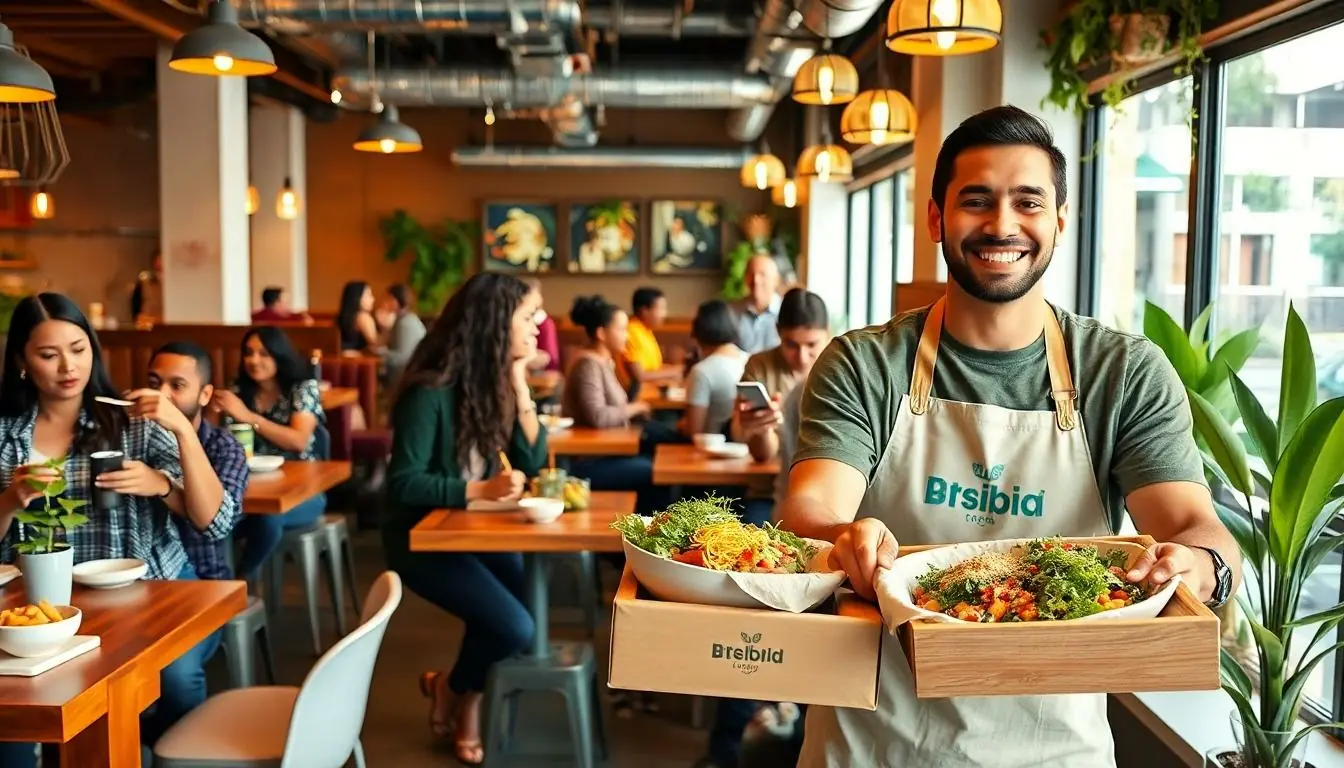Fast casual restaurants have taken the dining scene by storm, blending the best of quick service with a dash of culinary flair. Picture this: gourmet burgers, artisanal tacos, and salads that even your grandma would approve of—all served up in a laid-back atmosphere. As diners crave quality without the wait, these eateries are stepping up their game, and it’s more than just a trend; it’s a revolution on a plate.
Table of Contents
ToggleOverview of Fast Casual Restaurants
Fast casual restaurants provide a unique dining experience that merges the speed of quick service with high-quality ingredients. The concept appeals to consumers looking for gourmet options without sacrificing time. Popular menu items include gourmet burgers, artisanal tacos, and crafted salads, which offer both taste and presentation.
These establishments often feature a relaxed atmosphere, enabling diners to enjoy their meals in a comfortable setting. A significant trend in this sector is the focus on sustainability, with many restaurants prioritizing locally sourced ingredients and environmentally friendly practices. This commitment resonates with health-conscious consumers who prioritize quality and sustainability in their dining choices.
Innovative techniques in food preparation and presentation also contribute to the fast casual movement’s appeal. Restaurants are embracing modern culinary trends, like plant-based options or ethnic-inspired menus, which attract diverse clientele. High-quality customer service remains essential, differentiating these restaurants from traditional fast food establishments.
In addition, technology is reshaping the fast casual space. Many restaurants integrate online ordering, mobile apps, and self-service kiosks to streamline operations and enhance the customer experience. Contactless payment options have gained popularity, ensuring safety and convenience.
The growth rate of fast casual dining is significant, with the market projected to reach $200 billion by 2025. This upward trend highlights how consumer preferences evolve toward quality meals with minimal wait times. As competition intensifies, fast casual restaurants must adapt, innovating to stay relevant and appealing in an ever-changing landscape.
Current Trends in Fast Casual Restaurants

Fast casual restaurants evolve continuously, driven by the demand for quality and convenience. Several key trends illustrate this evolution.
Health-Conscious Options
Health-conscious options dominate fast casual menus. They feature nutrient-rich salads, grain bowls, and plant-based proteins. Many restaurants highlight clean ingredients, providing transparency about sourcing. Customers increasingly favor dishes with fewer additives, appealing to wide-ranging dietary preferences. Research shows that 73% of consumers prefer restaurants that offer healthier choices. Incorporating superfoods and gluten-free options enhances menu appeal. Crafting meals with whole, unprocessed ingredients boosts credibility among health-focused diners.
Sustainability Practices
Sustainability practices play a crucial role in fast casual dining today. Many establishments prioritize locally sourced ingredients, reducing carbon footprints. Restaurants commit to environmentally friendly packaging and waste reduction initiatives. Utilizing seasonal produce not only enhances flavor but supports local economies. According to industry reports, 62% of diners are willing to pay more for sustainable options. Creating partnerships with sustainable farms strengthens these practices. These efforts resonate with eco-conscious consumers, reinforcing brand loyalty.
Digital Ordering and Delivery
Digital ordering and delivery options surge in popularity within fast casual restaurants. Many establishments adopt user-friendly apps and websites for seamless transactions. Online ordering elevates customer convenience, facilitating quick meal pickups. Data indicates that 60% of consumers prefer online ordering to traditional methods. Contactless payment systems provide security, enhancing the overall experience. Collaboration with delivery services expands reach, allowing restaurants to tap into new markets. Emphasizing efficiency and speed attracts tech-savvy customers seeking modern dining solutions.
Popular Menu Innovations
Fast casual restaurants increasingly embrace innovative menu items that cater to evolving consumer tastes. These innovations often include unique flavors and healthy options that resonate with diverse diners.
Global Flavors
Fast casual dining sees a clear trend toward global flavors. Dishes influenced by international cuisines, such as Korean BBQ bowls or Mediterranean mezze platters, attract adventurous eaters. Chefs incorporate authentic ingredients and cooking techniques to enhance the dining experience. Diners appreciate variety, demonstrating an eagerness to explore different culinary traditions. Recent data indicates that ethnic-inspired menus have surged in popularity, showcasing the growing acceptance of bold flavors. As a result, restaurants constantly update menus, ensuring they reflect global tastes that entice customers seeking something beyond traditional offerings.
Plant-Based Alternatives
Diners increasingly favor plant-based alternatives at fast casual restaurants. Options like vegan burgers, lentil-based tacos, and cauliflower rice bowls appeal to health-conscious consumers. Restaurants respond by highlighting these innovative dishes, drawing in those interested in reducing meat consumption. The rise of plant-based diets coincides with increased demand for transparency in ingredient sourcing, prompting restaurants to feature clean, recognizable components. Research indicates a noteworthy increase in plant-based menu items, aligning with consumer preference for nutritious and sustainable meals. By prioritizing these alternatives, fast casual establishments cater to a growing market segment seeking delicious and environmentally friendly choices.
Consumer Demographics and Preferences
Fast casual restaurants attract a diverse clientele, primarily consisting of millennials and Gen Z consumers. These groups prioritize quality ingredients and sustainable practices, shaping their dining choices. Health-conscious diners gravitate toward nutrient-dense options, such as salads and plant-based proteins, reflecting a shift in demand. Patrons increasingly seek transparency in ingredient sourcing and preparation methods, making it essential for restaurants to communicate their practices clearly.
Among these consumers, 70% express concern over food quality, insisting on fresh, locally sourced ingredients. The appeal extends to eco-conscious diners, who favor establishments that implement sustainable packaging and environmentally friendly operations. This demographic engages frequently with technology, indicating a strong preference for mobile ordering and contactless payments.
Innovative menu items also resonate with diners, who show enthusiasm for globally influenced flavors from cuisines like Korean BBQ and Mediterranean dishes. As preferences evolve, fast casual restaurants adapt by emphasizing diverse culinary options, catering to the adventurous tastes of their customers. Feedback reveals that 65% of diners are more likely to visit restaurants that offer unique dishes that reflect current food trends.
Transparency becomes crucial, especially with the growing interest in plant-based alternatives. Consumers increasingly align their values with their food choices, driving restaurants to highlight health benefits alongside taste. Fast casual establishments that respond to these preferences effectively position themselves for success in the competitive dining landscape.
Demographic trends indicate that younger consumers are likely to experiment with unfamiliar dishes, creating opportunities for innovation in menu offerings. Ultimately, understanding these demographics and their preferences equips fast casual restaurants to thrive in a constantly changing market.
The fast casual restaurant sector is clearly evolving to meet the demands of today’s consumers. With a focus on quality food and sustainability these establishments are redefining dining experiences. The integration of innovative menu items and health-conscious options reflects a growing interest in diverse culinary traditions.
As technology continues to shape consumer interactions the rise of digital ordering and contactless payments enhances convenience and accessibility. Fast casual restaurants that prioritize transparency and sustainability are likely to thrive as they cater to a more informed and eco-conscious clientele.
The future of this industry looks promising as it adapts to the changing preferences of diners seeking both quality and efficiency.





